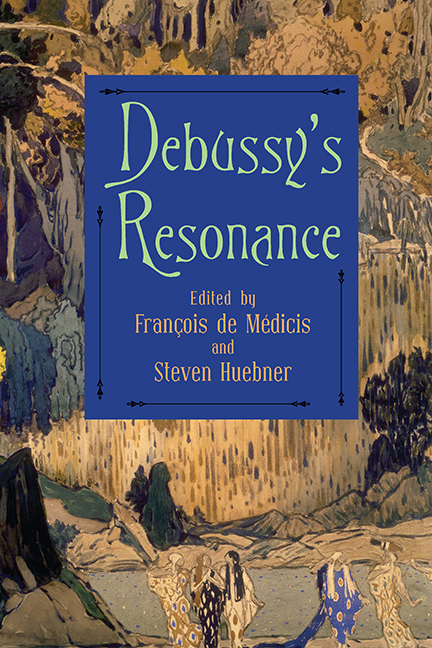Book contents
- Frontmatter
- Contents
- List of Illustrations
- Acknowledgments
- List of Abbreviations
- Introduction
- Part One Historiographical and Editorial Issues
- Part Two Style and Genre
- Part Three History and Hermeneutics
- Part Four Theoretical Issues
- 14 Follow the Leader: Debussy's Contrapuntal Games
- 15 Debussy's Absolute Pitch: Motivic Harmony and Choice of Keys
- 16 Debussy's G♯/A♭ Complex: The Adventures of a Pitch-Class from the Suite bergamasque to the Douze études
- 17 The Games of Jeux
- Part Five Performance and Reception
- List of Contributors
- Index
17 - The Games of Jeux
from Part Four - Theoretical Issues
Published online by Cambridge University Press: 27 July 2019
- Frontmatter
- Contents
- List of Illustrations
- Acknowledgments
- List of Abbreviations
- Introduction
- Part One Historiographical and Editorial Issues
- Part Two Style and Genre
- Part Three History and Hermeneutics
- Part Four Theoretical Issues
- 14 Follow the Leader: Debussy's Contrapuntal Games
- 15 Debussy's Absolute Pitch: Motivic Harmony and Choice of Keys
- 16 Debussy's G♯/A♭ Complex: The Adventures of a Pitch-Class from the Suite bergamasque to the Douze études
- 17 The Games of Jeux
- Part Five Performance and Reception
- List of Contributors
- Index
Summary
The story is a familiar one: a ballet is premièred in Paris in the spring of 1913 by the Ballets Russes with choreography by Nijinsky. The ballet is considered the composer's most modern work to date and soon viewed as one of the seminal works of the early century. After 1950 it elicits a number of analytic inquiries. These scholarly essays seek to find coherence through a variety of technical means but concentrate on the ballet score alone. One recent writer made this last point explicitly by basing his study solely on the “musical construction” since, as he argued, the interdisciplinary aspects of the work were soon forgotten after its première. This approach prompted another scholar—the former's “public adversary, private pal”—to question such studies of “the music itself” and to champion hermeneutics. It will be clear that I have been describing the première of Stravinsky's Le sacre du printemps, though before this point in the story, the description could have applied equally well to the première of Debussy's Jeux. To continue the similarities between these two ballets, scholarly inquiry into Jeux has concentrated on the musical score alone with little, if any, reference to ostensibly external factors. This study will instead be both analytical and hermeneutical, with the goal of showing that the formal organization of the ballet gains insight from the study not only of the music, but also of the stage directions, as well as of the contemporary events in Debussy's personal life.
An examination of Debussy's life in the context of a study of Jeux might initially seem a fruitless line of inquiry. Debussy's friendship with Stravinsky, however, turns out to have been a major event in the French composer's life. Although the musical relationship between these two composers has most frequently been approached in terms of what Stravinsky learned from Debussy, this musical influence actually worked both ways. This is to say that Stravinskian fingerprints appear in Debussy's compositions beginning in 1910. For example, Howat has noted “a methodical exploration of octatonic techniques” after 1910, the year the two composers met. This reaction was undoubtedly the result of Debussy's unequivocally positive reaction to Petrushka, which prompted him to incorporate the Petrushka chord, using the same triads in the same inversions, into his little-known ballet Khamma (see ex. 17.1).
- Type
- Chapter
- Information
- Debussy's Resonance , pp. 476 - 510Publisher: Boydell & BrewerPrint publication year: 2018



